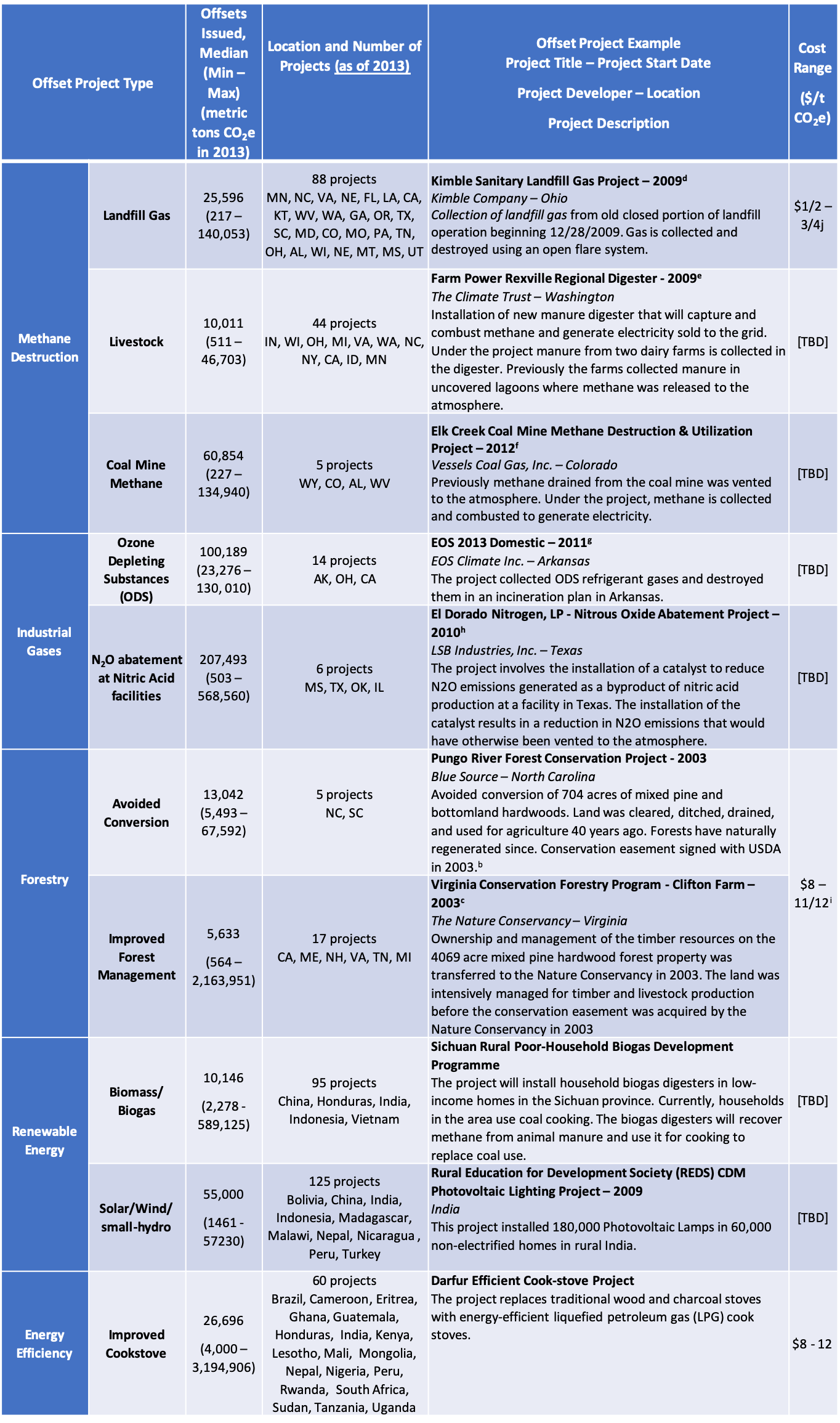Carbon offset credits can be produced by a variety of activities that reduce GHG emissions or increase carbon sequestration. In most cases, these activities are undertaken as discrete “projects.” A carbon offset project, for example, may involve:
- Renewable energy development (displacing fossil-fuel emissions from conventional power plants);
- The capture and destruction of high-potency GHGs like methane, N2O, or HFCs; or
- Avoided deforestation (which can both avoid the emission of the carbon stored in trees, as well as absorb additional carbon as trees grow).
Projects can range in scale from very small (e.g., reducing a few hundred tonnes of CO2e per year) to very large (e.g., millions of tonnes reduced per year). Carbon offset credits are also sometimes produced by large-scale “programs of activities,”[1] which aggregate together many similar small projects or coordinated efforts across entire jurisdictions (such as in the case of avoided deforestation).[2]
In many cases, carbon offset projects produce social and environmental benefits beyond just GHG reductions. Depending on the project type, these “co-benefits” can include improvements to community employment opportunities; enhanced air or water quality; biodiversity and habitat conservation; improved energy access; and better access to community health and education services. Many offset credit buyers seek projects that yield a broad range of benefits. Carbon offsets can thus be part of a comprehensive strategy for corporate social responsibility, combining efforts to address climate change with contributions to other public goods.
One challenge is that the types of projects that make for higher-quality carbon offsets tend to be those with the fewest co-benefits – and vice versa (see Sticking to lower-risk project types).
Sample Offset Types and Information
The table below presents select project types and provides a snapshot of the project’s size, geographic location, and the number of projects of that type (as of 2013).

Note: the above example projects are offered to identify projects developed within the project type, but have not been reviewed by GHGMI/SEI and are not endorsed in any way.
Related pages:
Table references:
a Climate Action Reserve Project Registry. Available at: https://thereserve2.apx.com/myModule/rpt/myrpt.asp?r=112
bDNV, 2012. Climate Action Reserve Verification Report. Prepared for Blue Source, LLC. CAR 659. Available at: http://marketplace.conservationregistry.org/assets/0000/9984/Pungo_River_project_Verification_Report.pdf
cClimate Action Reserve, n.d. Project Information for the Virginia Conservation Forestry Program – Clifton Farm. Available at: https://thereserve2.apx.com/mymodule/reg/prjView.asp?id1=686
d Climate Action Reserve, n.d. Project Information for the Kimble Sanitary Landfill Gas Project. Available at: https://thereserve2.apx.com/mymodule/reg/prjView.asp?id1=621
eClimate Action Reserve, n.d. Project Information for the Farm Power Rexville Regional Digester. Available at: https://thereserve2.apx.com/mymodule/reg/prjView.asp?id1=416
fClimate Action Reserve, n.d. Project Information for the Elk Creek Coal Mine Methane Destruction & Utilization Project. Available at: https://thereserve2.apx.com/mymodule/reg/prjView.asp?id1=891
gClimate Action Reserve, n.d. Project Information for EOS ARB ODS 2013-3. Available at: https://thereserve2.apx.com/mymodule/reg/prjView.asp?id1=416
hClimate Action Reserve, n.d. Project Information for El Dorado Nitrogen, LP – Nitrous Oxide Abatement Project – 2010. Available at: https://thereserve2.apx.com/mymodule/reg/prjView.asp?id1=639
[1] Such “programs” were pioneered under the Kyoto Protocol’s Clean Development Mechanism; see here.
[2] See, for example, Verra’s framework for Jurisdictional and Nested REDD+ programs. (REDD stands for “reduced emissions from deforestation and forest degradation”.)
